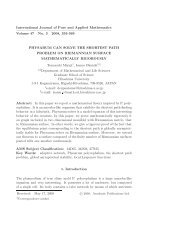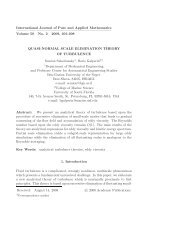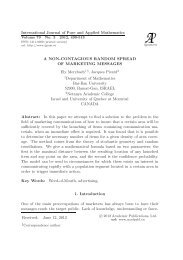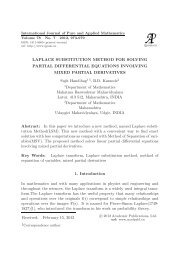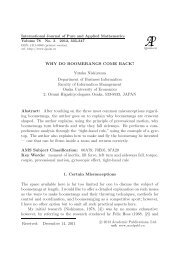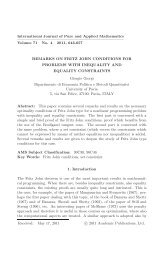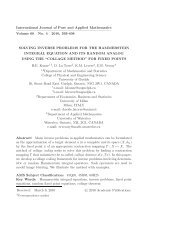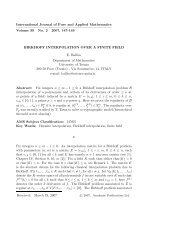FINDING N-TH ROOTS IN NILPOTENT GROUPS AND ...
FINDING N-TH ROOTS IN NILPOTENT GROUPS AND ...
FINDING N-TH ROOTS IN NILPOTENT GROUPS AND ...
You also want an ePaper? Increase the reach of your titles
YUMPU automatically turns print PDFs into web optimized ePapers that Google loves.
<strong>F<strong>IN</strong>D<strong>IN</strong>G</strong> N-<strong>TH</strong> <strong>ROOTS</strong> <strong>IN</strong> <strong>NILPOTENT</strong> <strong>GROUPS</strong>... 587<br />
Theorem 7.2. (Zorn, 1936) Every finite Engel group is nilpotent.<br />
Theorem 7.3. (Gruenberg, 1953) Every finitely generated solvable Engel<br />
group is nilpotent.<br />
Theorem 7.4. (Baer, 1957) Every Engel group satisfying max is nilpotent.<br />
Theorem 7.5. (Suprenenko and Garscuk, 1962) Every linear Engel group<br />
is nilpotent.<br />
Proposition 7.6. The Heisenberg group is a 2-Engel group.<br />
Proof. We want to show that [[X,Y ],Y ] = I. Let X = A m B n C k =<br />
⎛ ⎞<br />
1 m k + mn<br />
⎝0<br />
1 n ⎠ and Y = A<br />
0 0 1<br />
uBvC w ⎛ ⎞<br />
1 u w + uv<br />
= ⎝0<br />
1 v ⎠. Then X<br />
0 0 1<br />
−1 =<br />
⎛ ⎞<br />
1 −m −k<br />
⎝0<br />
1 −n⎠<br />
and Y<br />
0 0 1<br />
−1 ⎛ ⎞<br />
1 −u −w<br />
= ⎝0<br />
1 −v⎠.<br />
Next, [X,Y ] = X<br />
0 0 1<br />
−1Y −1XY =<br />
⎛<br />
⎞<br />
1 0 −nu + mv<br />
⎝0<br />
1 0 ⎠. Finally, [[X,Y ],Y ] = [X,Y ]<br />
0 0 1<br />
−1Y −1 ⎛ ⎞<br />
1 0 0<br />
[X,Y ]Y = ⎝0<br />
1 0⎠.<br />
0 0 1<br />
Lemma 7.7. Every element in the Heisenberg group satisfies Y X 2 Y =<br />
XY 2 X.<br />
Proof. We will prove a more general case: in every 2-Engel group, yx 2 y =<br />
xy 2 x. To see this, note that<br />
[y,x][x −1 ,y −1 ] = [y,x]xyx −1 y −1 = x[y,x]yx −1 y −1<br />
= x[y,x]yx −1 y −1 xx −1 = x[y,x][y −1 ,x]x −1<br />
= x[e,x]x −1 = e.<br />
From this, we conclude that [y,x] = [x −1 ,y −1 ] −1 = [y −1 ,x −1 ], which is equivalent<br />
to yx 2 y = xy 2 x.<br />
There are other semigroup laws for other Engel groups. Here, we will discuss<br />
the laws for 3-Engel and 4-Engel groups.



